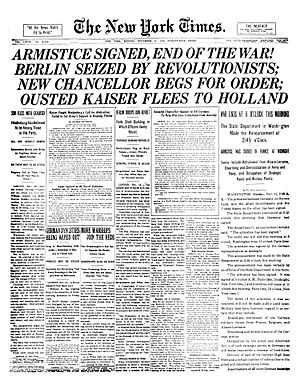Headline facts for kids

A headline is a short piece of text found at the very top of an article. It tells you what the article is about. Think of it as a quick summary or a catchy title that grabs your attention. Newspapers, magazines, and websites all use headlines to help readers quickly understand the main idea of a story.
Contents
What is a Headline?
A headline is like the front door to a story. It's the first thing you see and it should make you want to read more. Its main job is to give you a hint about the nature of the article below it. Good headlines are usually short and to the point. They use strong words to get their message across quickly.
Why Are Headlines Important?
Headlines are super important for several reasons:
- They grab attention: In a world full of information, a good headline makes a story stand out. It makes people curious enough to click or pick up a newspaper.
- They summarize: A headline gives you the main idea of a story in just a few words. This helps you decide if you want to read the whole article.
- They inform: Even if you only read the headline, you can often get a basic understanding of what happened. For example, "Local Team Wins Championship" tells you a lot right away.
- They help organize: Headlines break up long articles into smaller, easier-to-read sections. This makes it simpler to find the information you are looking for.
Different Kinds of Headlines
Headlines come in many shapes and sizes, depending on where they are used and how important the news is.
- Banner headlines: These are very large headlines that stretch across the entire top of a newspaper page. They are used for the biggest news stories, like major historical events.
- Deck headlines: Sometimes, a main headline will have one or more smaller headlines underneath it. These are called "decks" or "sub-headlines." They add more detail to the main headline.
- Kickers: A "kicker" is a short, often catchy headline placed above the main headline. It can set the tone or add a bit of extra context.
- Subheads: Within a longer article, you'll often see smaller headlines that break up the text. These are called "subheads" or "section headings." They introduce new topics within the article.
Main Headlines: Banners and Decks
Imagine a newspaper reporting on a huge event, like a new discovery. The main headline might be very big and bold, saying something like "SCIENTISTS DISCOVER NEW PLANET!" This is a banner headline. Right below it, a smaller deck headline might add, "Telescopes spot distant world with signs of water." This gives more information without making the main headline too long.
Smaller Headlines: Kickers and Subheads
A kicker might be used to add a bit of flair. For example, above the main headline "NEW SCHOOL OPENS," a kicker could say "A Bright Future Begins." Subheads are used inside the article to guide you. If an article is about the new school, subheads might be "Building Features," "Student Programs," and "Community Impact."
How Are Headlines Written?
Writing a good headline is an art! Journalists and editors follow some rules to make them effective:
- Keep it short: Most headlines are only a few words long.
- Use strong verbs: Action words make headlines exciting. Instead of "The team was victorious," a headline might say "Team Triumphs!"
- Be clear: The headline should not confuse the reader. It should clearly state what the story is about.
- Include keywords: For online articles, headlines often include words that people might search for. This helps more people find the story.
- Active voice: Headlines usually use active voice (e.g., "Dog bites man" instead of "Man was bitten by dog") because it's more direct.
Headlines in the Digital Age
With the rise of the internet, headlines are more important than ever. On websites, social media, and news apps, headlines are what make you click on a story. Online headlines often try to be very catchy or even use questions to make you curious. They are also designed to work well with search engines, so people can easily find news and information.

